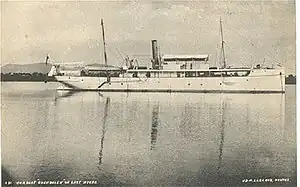SS Gwendolen
SS Gwendolen (sometimes misspelled Guendolen and Gwendolyn) was a British steamship on Lake Nyasa[1] that fought in the first naval action of World War I against the German steamship Hermann von Wissman which it caught on a slipway at Sphinxhafen, now known as Liuli.[2]
 | |
| History | |
|---|---|
| Name | Gwendolen |
| Namesake | Lady Gwendolen Cecil (1860–1945) |
| Launched | 1899 |
| General characteristics | |
| Type | ferry |
| Length | 136 feet (41 m) |
| Beam | 24 feet (7.3 m) |
| Draught | 5.5 feet (1.7 m) |
| Depth | 19 feet (5.8 m) |
| Installed power | steam |
| Propulsion | screw |
The 350-ton vessel was launched at Fort Johnston in 1899, and named after Lady Gwendolen Cecil, the then 29-year-old unmarried daughter of the Marquess of Salisbury.[3] In 1907 the Gwendolen was the largest of three vessels formerly used as gunboats, the others being the SS Chauncy Maples and the Queen Victoria, with four civilian steamers on the lake.[4]
From 1914 she was commanded by Captain Edmund Rhoades, who attacked the Hermann von Wissman, the vessel of his friend and former drinking partner Captain Berndt, by surprise, with Berndt having been unaware that war had started.[5] William Percival Johnson later recalled that Captain Berndt, who had been master of the German vessel for its original purpose as an anti-slavery gunboat in the 1890s, had been a good friend of the British missionaries in the days of Chauncy Maples.[6]
In the 1920s the Nyasaland Government Marine Transport ran a monthly sailing of SS Gwendolen from Fort Johnston carrying goods and passengers on a 15-day round trip around various ports on the lake.[7]
References
- The Guendolen (photo)
- Warship International. International Naval Research Organization, Naval Records Club (U.S.). 17. 1980.
{{cite journal}}: Missing or empty|title=(help) "The Germans made repairs to the Von Wissmann but Gwendolen again arrived on the scene on May 30, 1915 when Von Wissmann was sent to ... The British also had two other vessels on Lake Nyasa named Chauncy Maples and Queen Victoria." - The Railway News. 75. 1901.
{{cite journal}}: Missing or empty|title=(help) "The steamer, which was christened the Gwendolen, after Lord Salisbury's daughter, is 136 ft. long, 24 ft. beam, 19 ft. moulded depth, and has a mean draught of 5 ft. 6 in. Although her tonnage is not registered, 350 tons is a fair ..." - Martin, Frederick; Keltie, Sir John Scott; Renwick, Isaac Parker Anderson (1907). "The Statesman's Yearbook". 44.
{{cite journal}}: Cite journal requires|journal=(help) "This consists of three vessels, formerly used as gunboats, including the Gwendolen, 350 tons, launched in 1899 at Fort Johnston, which is the headquarters of the department. For ordinary traffic there are 4 small steamers on the Lake ... - Briggs, Philip (2010). Malawi (5th ed.). p. 299. "Rhoades was then startled to see his enraged German counterpart and old drinking partner, Captain Berndt, leap into a dinghy and climb aboard the Gwendolyn screaming curses and questioning Rhoades's sanity. It transpired that news of the war had not reached Liuli. Rhoades sat Berndt down with a whisky, explained the situation, then led away his angry prisoner of war"
- Good, Charles M. (2004). The steamer parish: the rise and fall of missionary medicine on an... p. 95. "Johnson recalled that "our very good friend Captain Berndt," in command of the German steamer Hermann von Wissmann, "was a very frequent visitor in Maples' time" (Johnson 1926, 211; cf. CA 12 [1894]: 71)."
- An Economic survey of the colonial empire Great Britain. Colonial Office. 1936. "For many years the Nyasaland Government Marine Transport operated a monthly sailing of the SS Guendolen from Fort Johnson carrying goods and passengers to various ports on the Lake, the round trip taking 15 days."